A festive, heavily spiced, deeply dark, slightly sticky & delicious Vegan Gingerbread Cake, smothered in rivers of orange glaze!
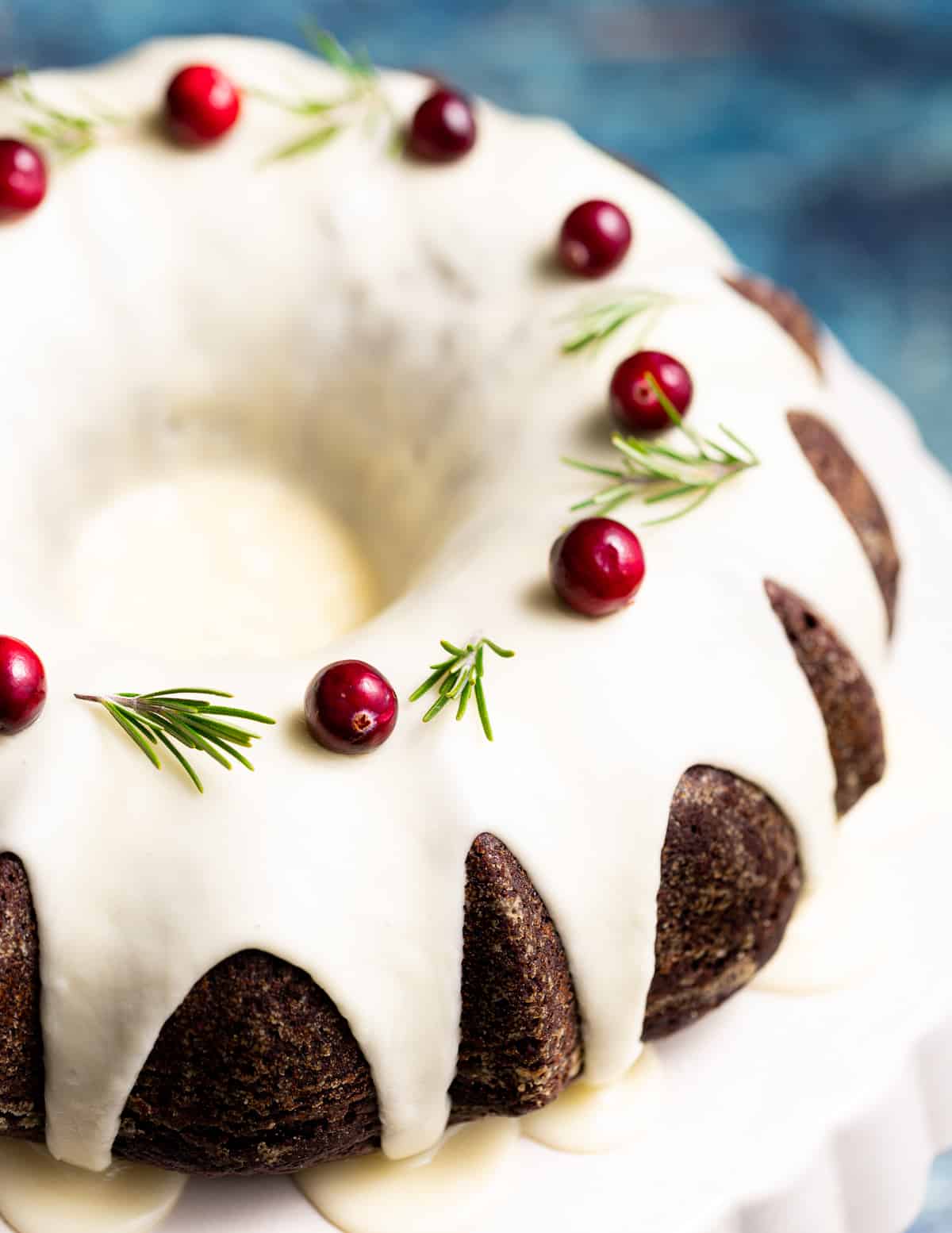
💌 SAVE THIS RECIPE!
Watch out for more tasty treats coming your way too! Unsubscribe at any time.
Get your festive pants on because Vegan Gingerbread Cake is happening! We're talking a gorgeous, buttery, heavily spiced, deeply dark, slightly sticky and delicious cake with inappropriately huge rivers of orange frosting drizzle.
It's 100% as warming, fragrant and festive as a good vegan gingerbread cake should be. The sweet, subtle citrus hit from the glaze is such an amazing contrast to the spicy warmth of the gingerbread and works so well.
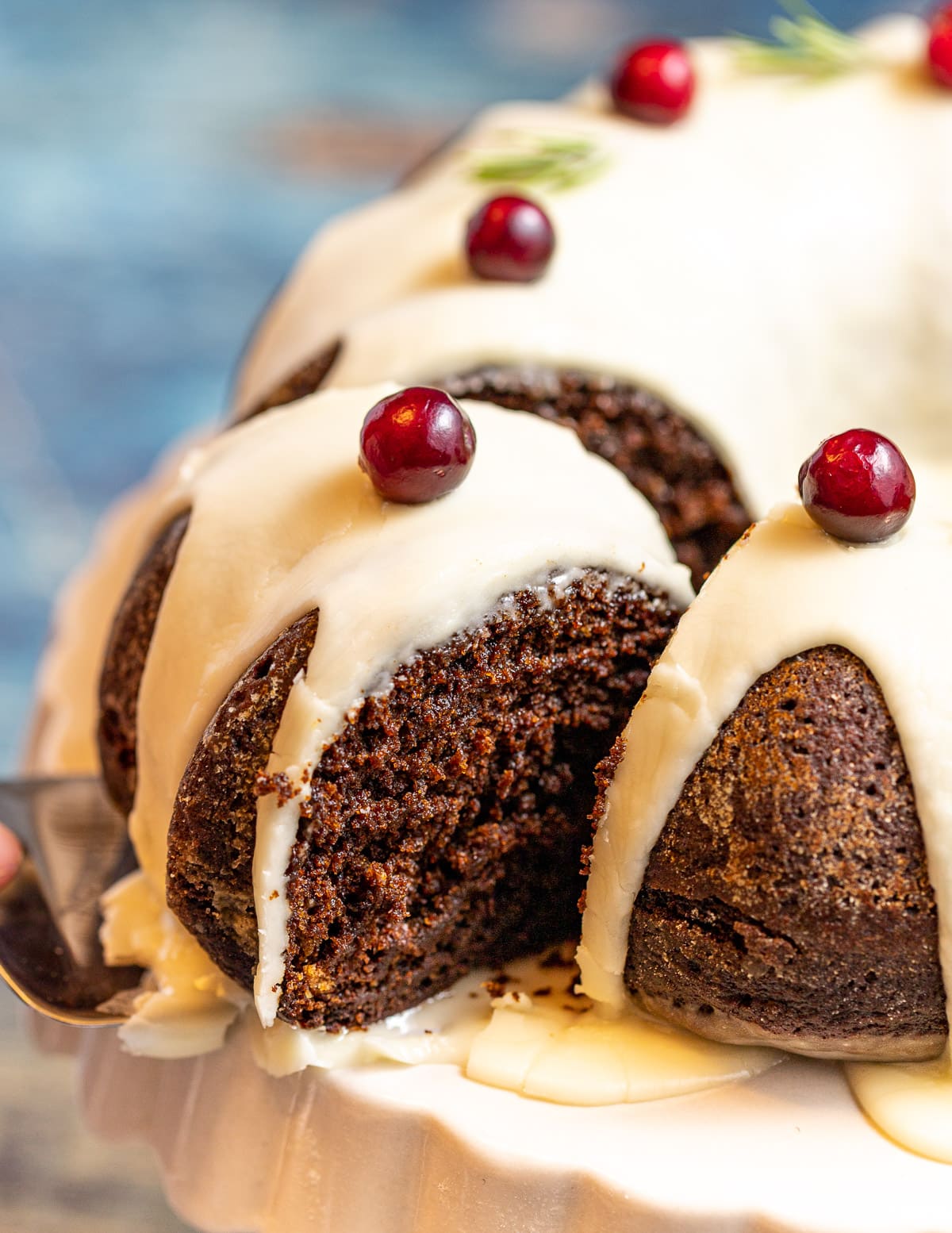
Ingredients
Here's the rundown on what's going on in this vegan bundt cake recipe and why:
- All-purpose flour – It's sturdy and works really well, giving the perfect dense but not too dense texture. I don’t recommend switching it for any other flour.
- Baking powder – Adds lift and airy fluffiness
- Baking Soda – The combination of baking soda and molasses creates a chemical reaction and makes bubbles and fizz. It is used as a replacement for the leavening usually provided by eggs and helps the cake rise well and become fluffier.
- Vanilla, ginger, cinnamon, cloves, black pepper & salt – Flavour, flavour, flavour! This is a very richly flavoured and festive cake. The black pepper might seem odd but it adds a lovely spicy, subtle heat. Don't skip it!
- Dark Brown Sugar – The kind that's dark and slightly sticky/clumpy in the bag. Important for moisture, depth of flavour and colour.
- Molasses - Absolutely essential in gingerbread. Go for dark molasses, usually labelled "unsulphured", sometimes labelled "robust". Blackstrap molasses is ok too. Do not reduce the amount. It is a lot but it is necessary for flavour, structure and moistness. I used Wholesome Sweeteners Organic Molasses.
- Vegan Butter- Adds flavour and moisture. I highly recommend you don't use anything else instead. Oil gives nowhere near as good a result. However, if you need to make the cake oil-free, natural, no additive almond or cashew butter will provide an ok, but slightly heavier result.
- Apple Sauce - We are packing the moisture into this cake. Good gingerbread cake should be moist and slightly sticky. This helps keep it that way for days and days after it's baked.
- Hot Water - Important for moisture and for dissolving the thick molasses
It might seem like there is a lot of moisture in here all of the wet ingredients guarantee a super moist bundt cake.
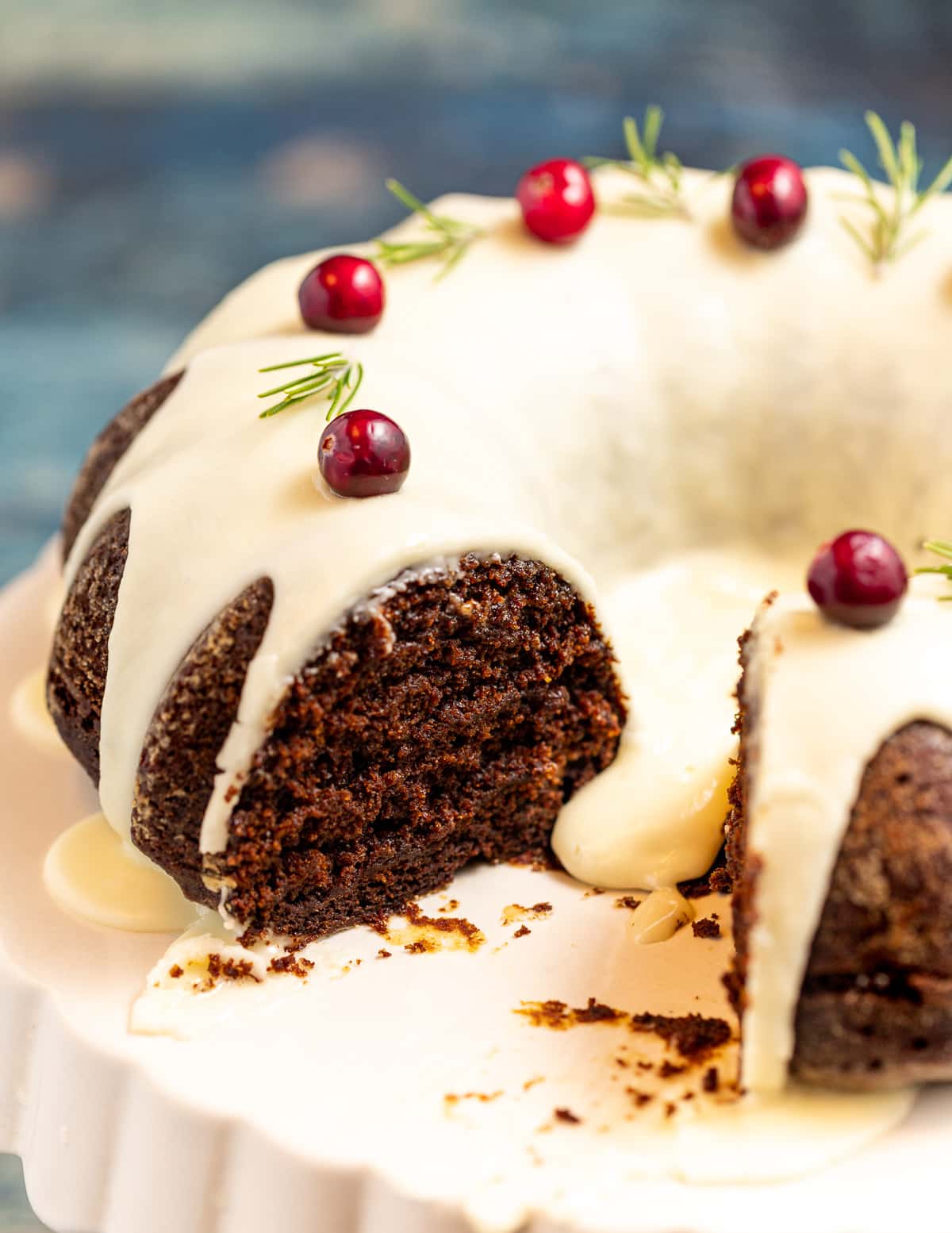
How To Make Vegan Gingerbread Cake
Here's how to make the cake:
- Grease the pan absolutely thoroughly. It's important to be very generous because this is a sticky cake. Be especially careful to get in all the nooks and crannies if using a bundt pan.
- Mix the molasses with boiling water. Stir until it is completely dissolved. Add the vanilla too.
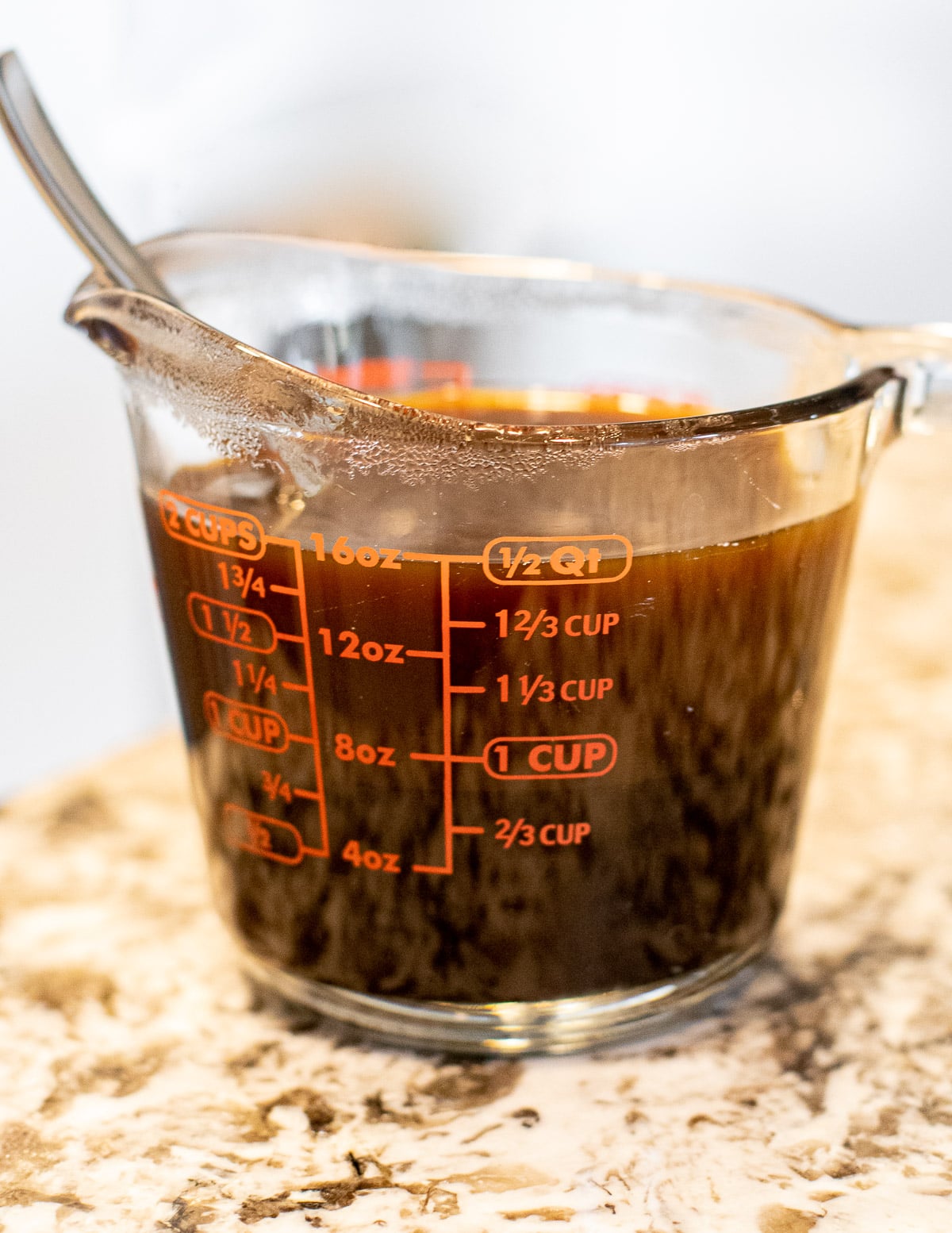
- Add all of the dry ingredients to a bowl and whisk them up.
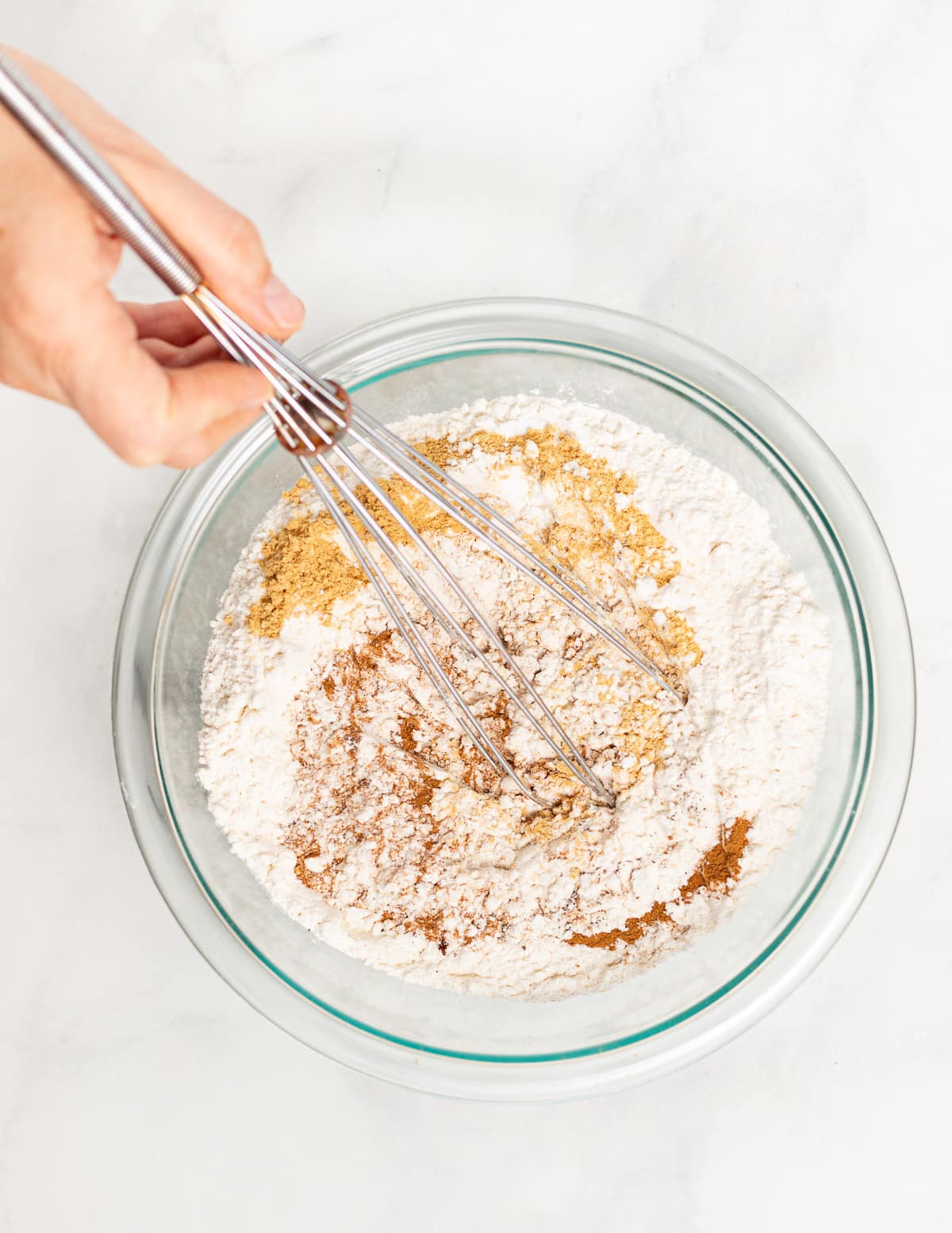
- Add the butter and sugar to another bowl (or a stand mixer) and beat them really well together until light and fluffy. It needs a good 5 minutes. Then add the apple sauce and beat again.
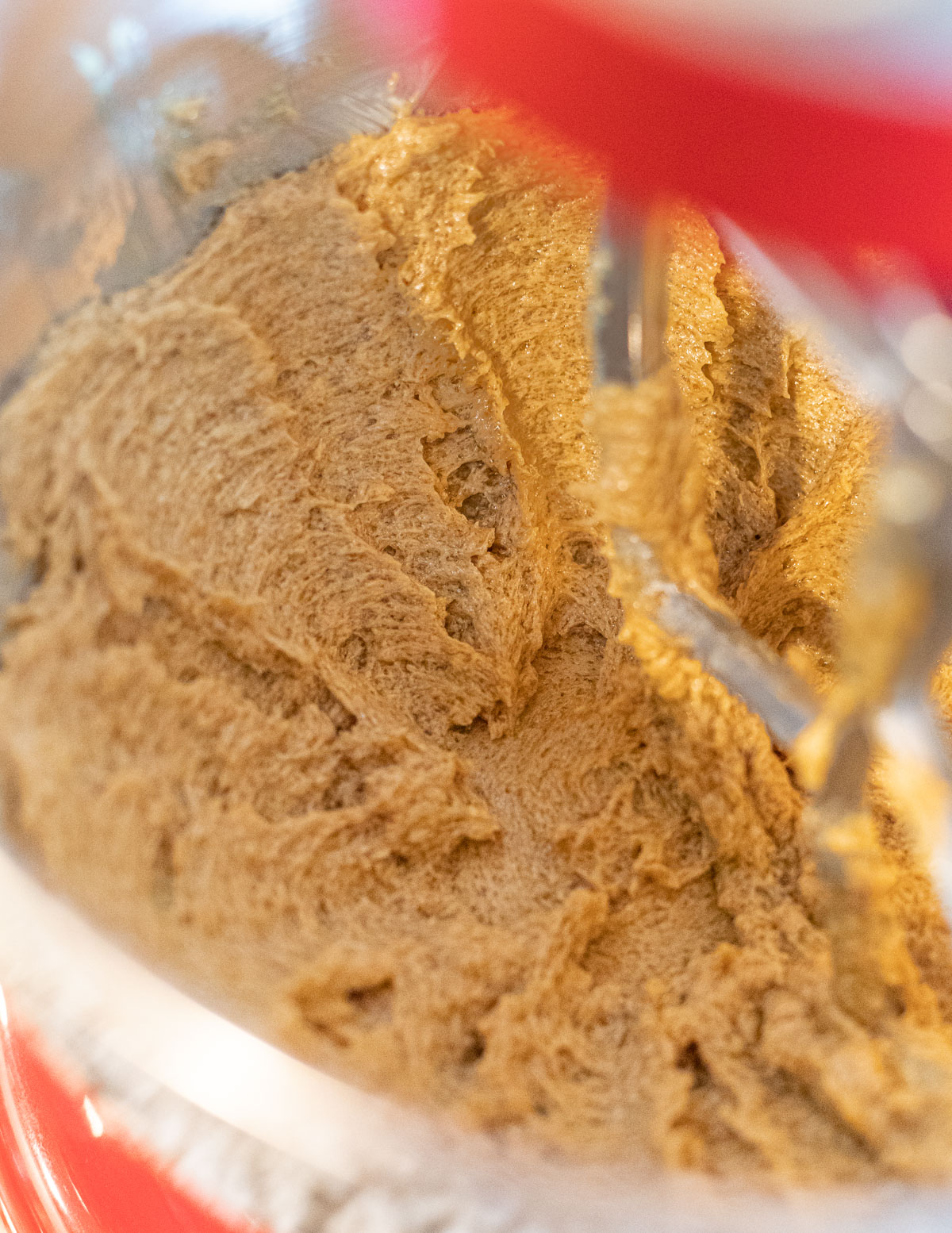
- Add the wet and the dry ingredients to the butter mixture gradually, alternating between the two and beating between additions until just combined. Don't over-mix.
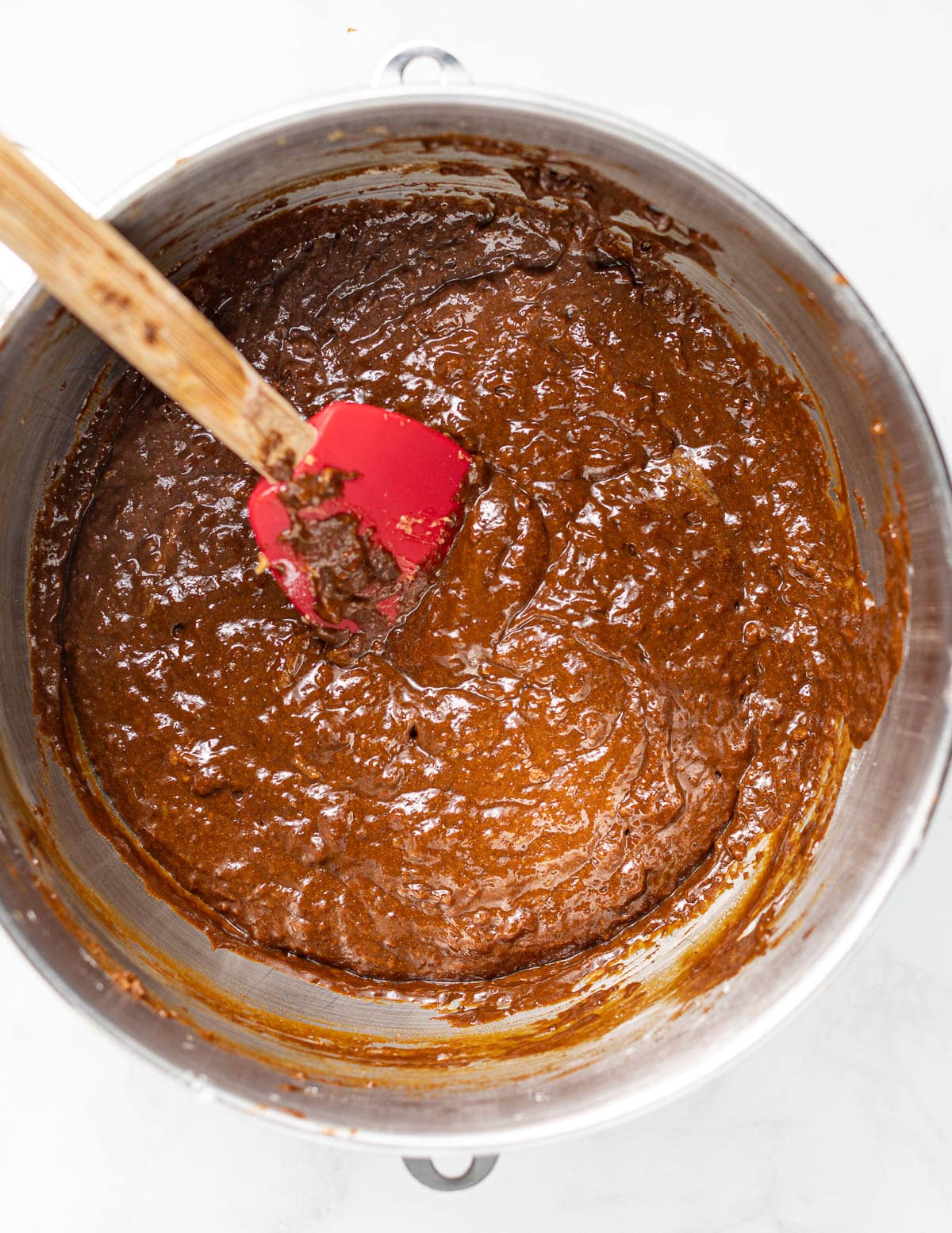
- Spoon into the bundt pan and bake.
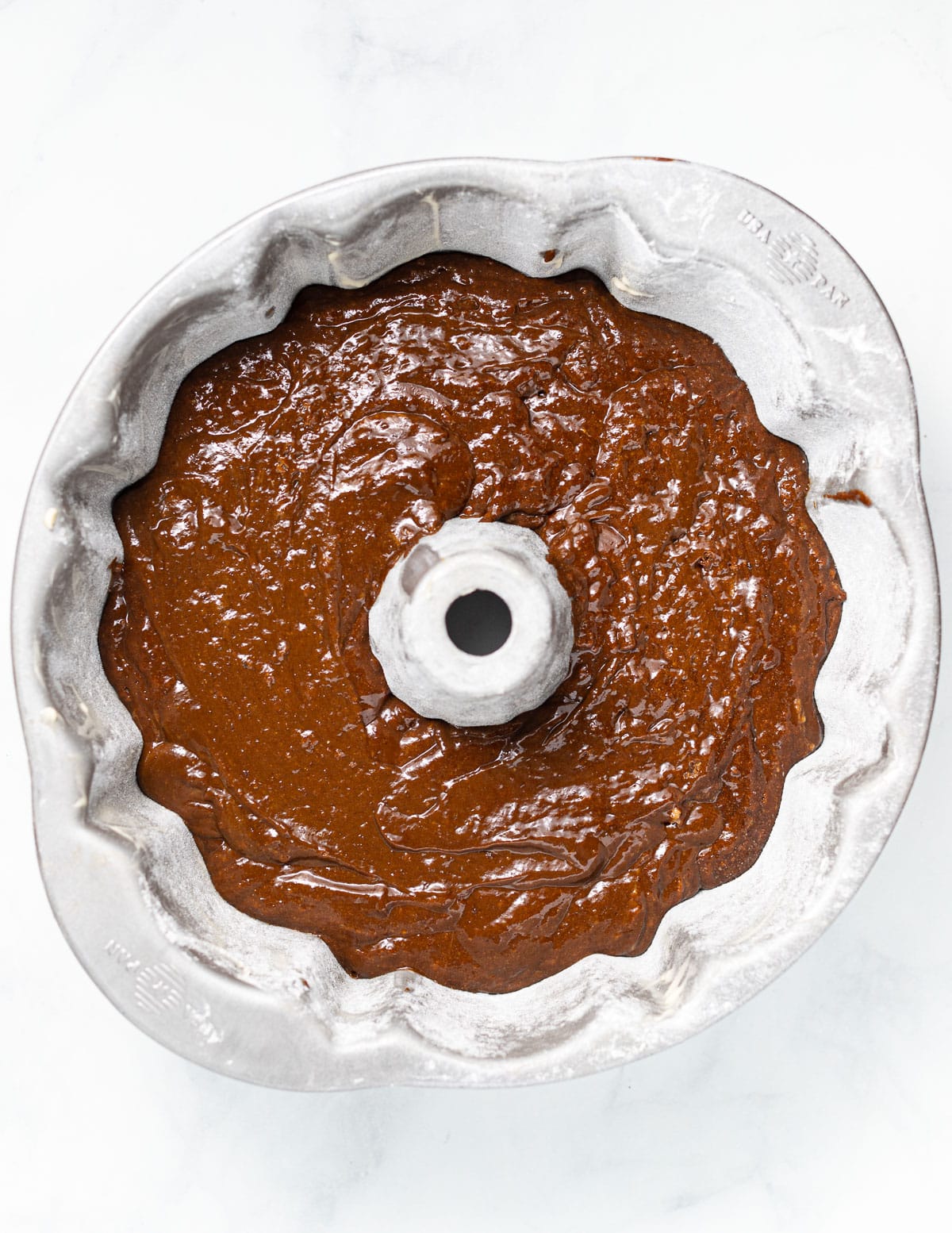
- And the important thing, when it's done, leave it in the pan until it's completely cool. This is really important!
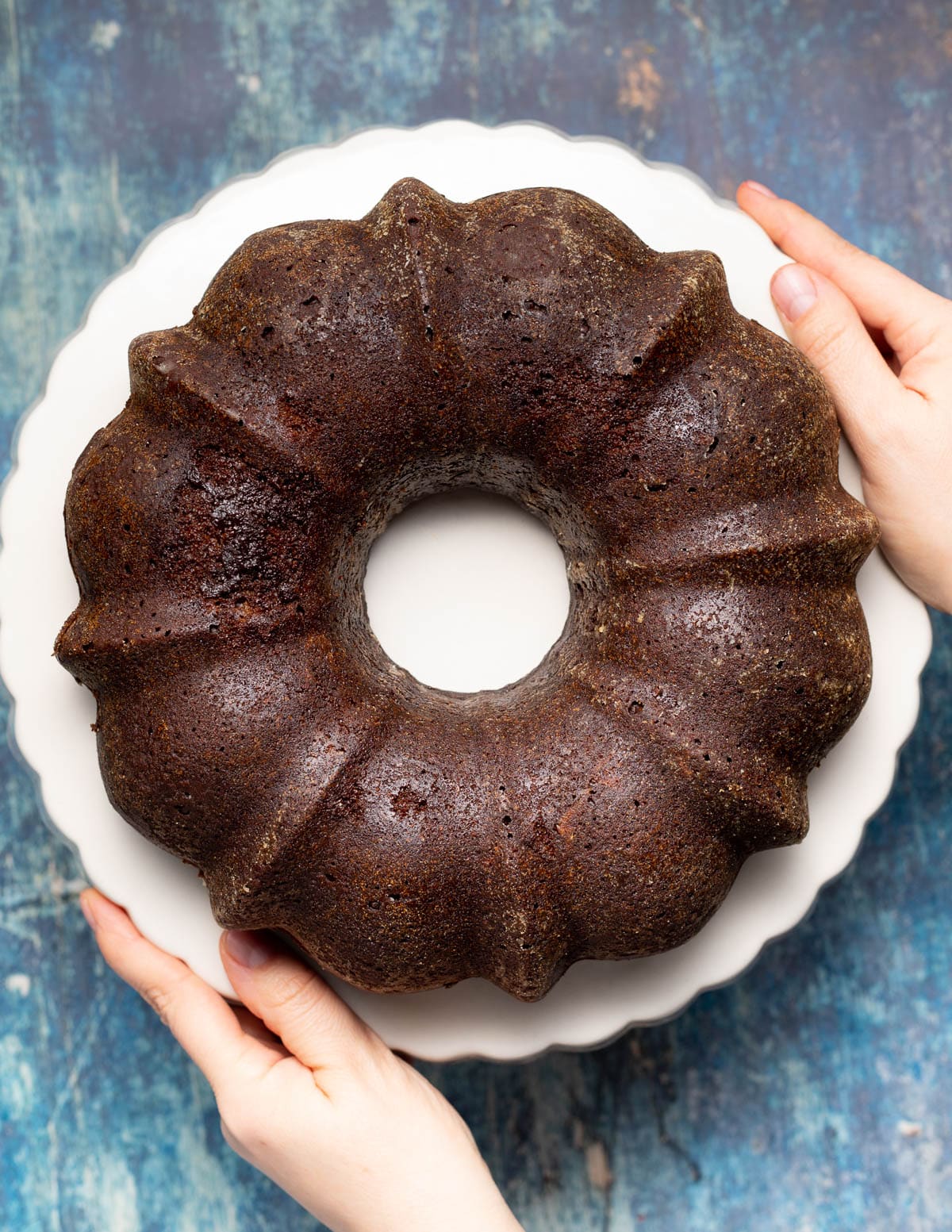
- Once it's cool, remove it from the pan, make the frosting and glaze the cake. See my tips for how to glaze neatly below.
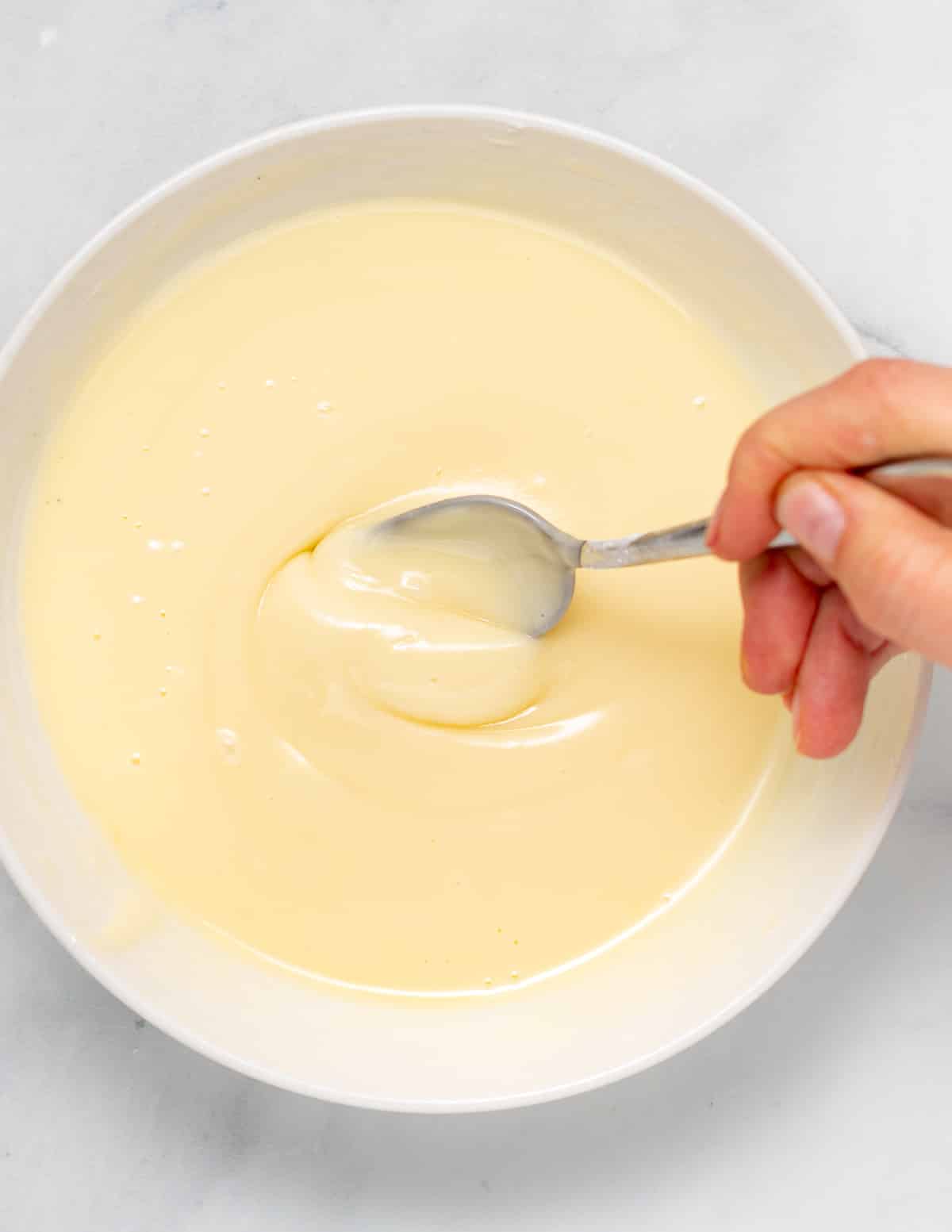
For decoration, you can't beat some fresh cranberries and fresh rosemary sprigs. They look so festive!
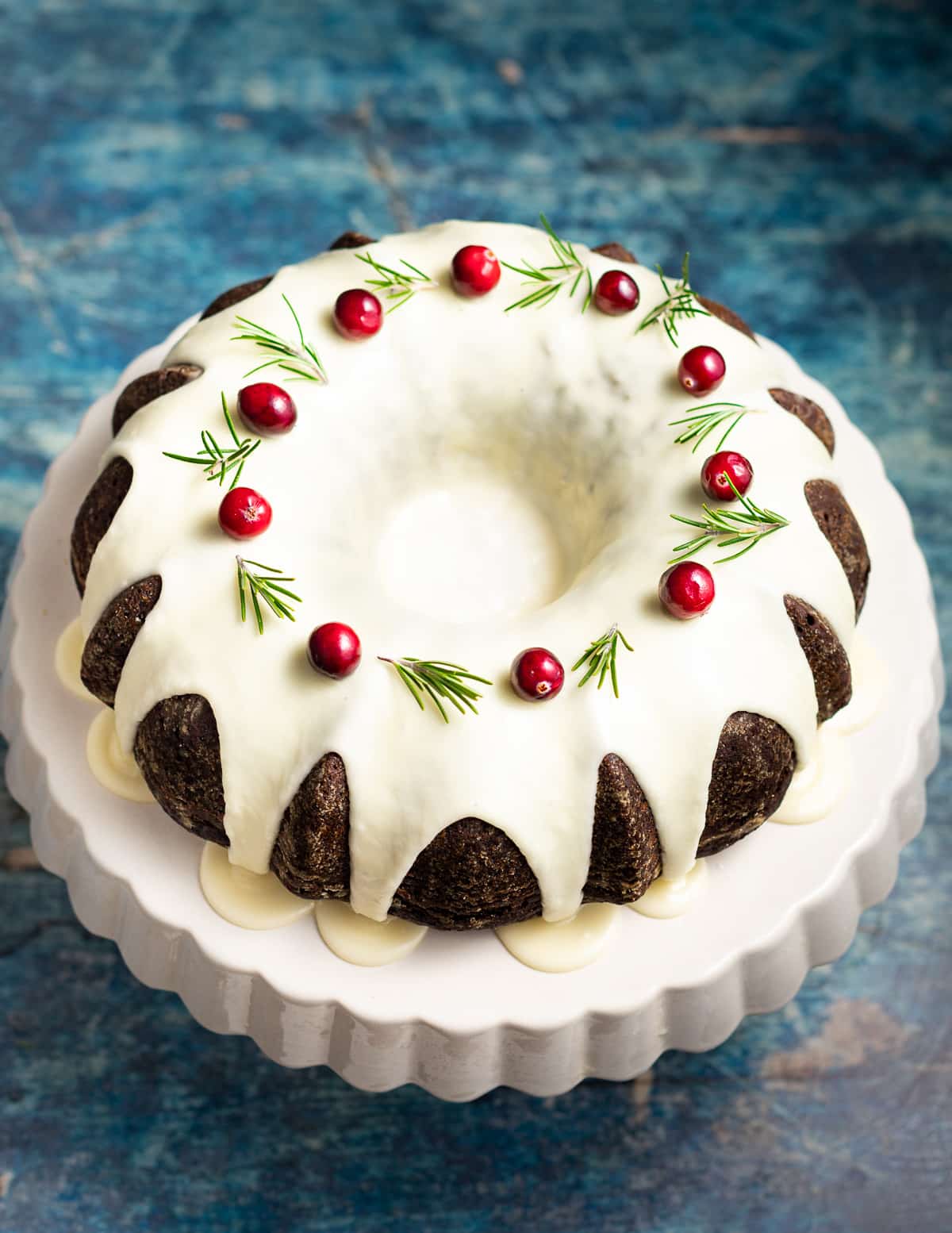
Variations
Although I don't recommend changing a lot, because baking is a science and the smallest thing can affect the outcome of the cake, this cake would be really good with additions such as candied ginger or chocolate chips. It's also really good made plain with no frosting then served with vegan custard or frosted with vegan cream cheese frosting.
For different pan sizes see the FAQs.
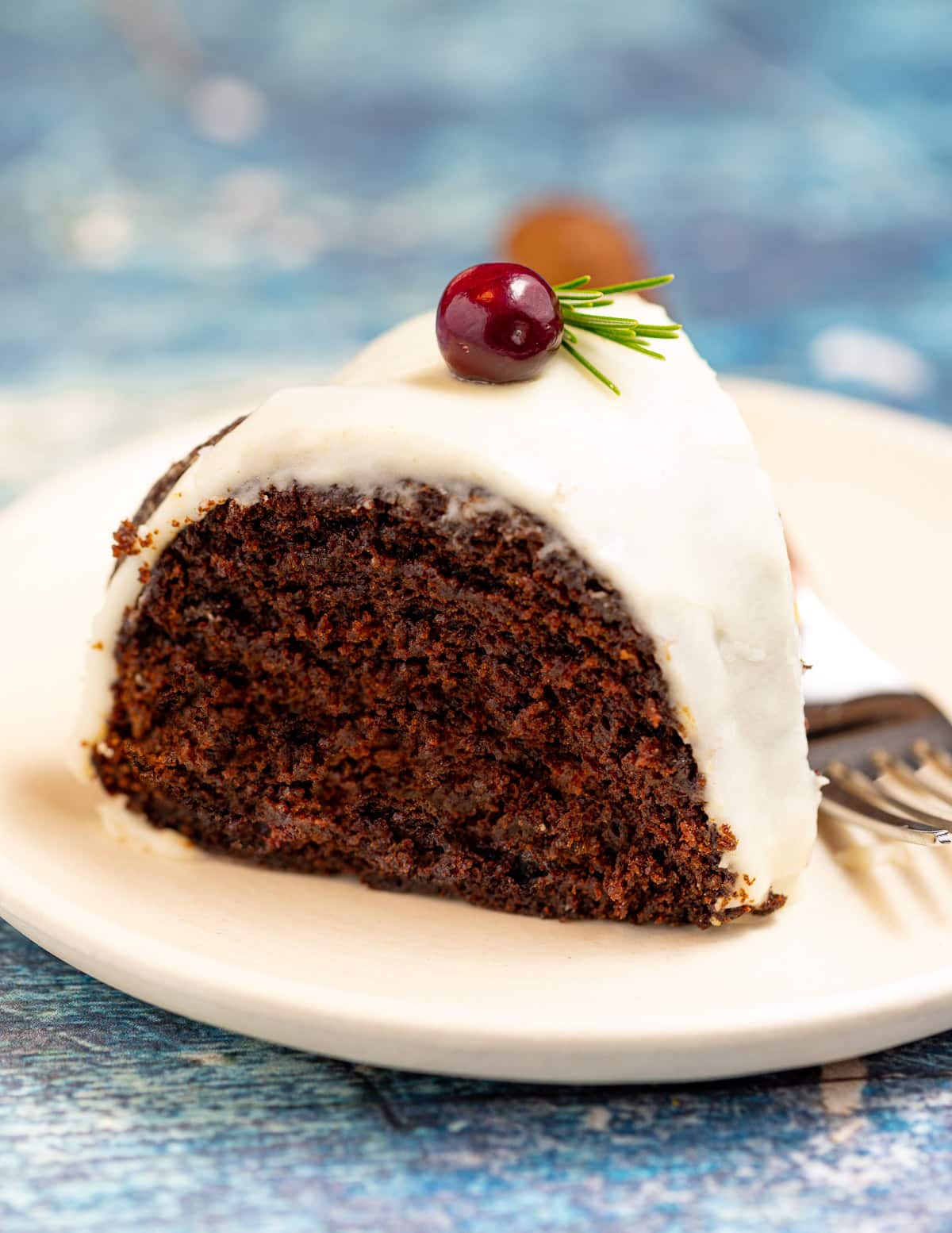
Tips For Storing
This cake stays perfectly moist for days and days. We have enjoyed it up to a week after it was baked. Just be sure to keep it well wrapped or in an airtight container. The flavour just keeps getting better and better! It's best to store it at room temperature as it can dry out in the fridge. We want it to stay soft and moist.
To freeze let the Vegan Gingerbread Cake cool completely in the pan, then remove and wrap very well. Freeze for up to 3 months. Allow to thaw overnight and then glaze or dust with powdered sugar before serving.
Recipe FAQs
The batter will fit into:
a 9 x 5 inch loaf pan (see the FAQ below for details)
1 (9 x 13 inch) pan
2 (9 inch) round cake pans
1 (9 inch) tube pan
1 (10 inch) spring form pan
Obviously, the baking times will change for all of these and I haven't been able to test the recipe in all of them to tell you exactly but:
In a 9 x 13 inch pan, start checking after 30 mins
In 2 x 9 inch cake pans start checking after about 23 mins
In a 9 inch tube pan start checking after about 35 - 40 mins
In a 10 inch spring form start checking after about 60 minutes
To check, use the toothpick test. Stick it into the centre and when you pull it out, if cooked, you should just see some moist crumbs sticking to it. If you poke the top gently with your finger it should bounce back and the cake should be just starting to come away from the sides of the pan.
I have tested this cake in a 9 x 5-inch loaf pan. You will need to reduce the ingredients as listed below. Follow exactly the same directions as for a bundt cake but first grease the pan then line it with baking parchment and bake for 40 to 45 minutes or until it's coming away from the edges of the pan slightly and a skewer/toothpick inserted come sout mostly clean but with some sticky crumbs on.
½ a cup and 2 tablespoons and 2 teaspoons (160 mls boiling water)
⅔ cup and 1 tablespoons (175ml) unsulphured molasses
1¼ teaspoon vanilla extract
5 ½ tablespoons (80 g) vegan butter
⅓ cup (67 g) dark brown sugar
2 tablespoons and 2 teaspoons of unsweetened applesauce
2 cups (250 g) all purpose flour (plain flour in the UK)
¾ teaspoon baking soda (bicarbonate of soda in the UK)
1 and a heaping ¼ teaspoon of baking powder
1 and a heaping ¼ teaspoon of ground ginger
1 and a heaping ¼ teaspoon of cinnamon
⅛ teaspoon ground cloves
¼ teaspoon fine salt
1 pinch freshly ground black pepper
1 cup (125 g) powdered sugar
2 - 4 tablespoons orange juice
When we alternate the dry and liquid ingredients, in 3 or 4 additions, beginning and ending with the dry ingredients, stirring just a little after each addition, but only until just combined, we reduce the chances of over-mixing and curdling.
This eggless Gingerbread Cake is a great make-ahead cake because it actually gets better with time. Those gorgeous spices continue to work their magic way after it comes out of the oven. It stays perfectly moist even 5 or 6 days after baking.
For best flavour and texture I recommend using vegan butter, but this cake can be made oil-free by using cashew or almond butter as the fat instead of butter. Use the same volume of drippy nut butter as butter. The cake will be denser but that's not necessarily a bad thing with a ginger cake. You will still need to grease the pan very well though.
More Cake Recipes
Recipe
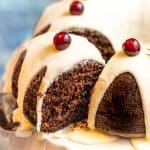
Vegan Gingerbread Cake
Author:Ingredients
- 1 cup (240 ml) boiling water
- 1 cup (240 ml) unsulphured molasses , dark molasses, sometimes labelled "unsulphured" or "robust". Use black treacle in the UK
- 2 teaspoons vanilla extract
- ½ cup (120 grams) vegan butter , plus a little more for greasing the pan
- ½ cup (100 grams) dark brown sugar
- ¼ cup (4 tablespoons) unsweetened applesauce , (in the UK cook a couple of apples down with 2 tbsp water until soft then blend to make applesauce)
- 3 cups (375 grams) all purpose flour , (plain flour in the UK)
- 1 teaspoon baking soda , (bicarbonate of soda in the UK)
- 2 teaspoons baking powder
- 2 teaspoons ground ginger
- 2 teaspoons ground cinnamon
- ¼ heaping teaspoon ground cloves
- ½ teaspoon fine salt
- ¼ teaspoon freshly ground black pepper
For the glaze
- 2 cups (250 grams) powdered sugar
- about 5 - 8 tablespoons fresh orange juice
Optional decorative items
- fresh cranberries
- fresh rosemary sprigs
RECOMMENDED EQUIPMENT
INSTRUCTIONS
- Adjust an oven shelf to the lower third of the oven, then preheat to 350 °F (175 °C). Grease a 9 to 10 inch Bundt Pan with plenty of vegan butter. (see recipe notes for other pan options)
- Put the boiling water in a jug or small bowl, and add the molasses. Stir really well until it has dissolved completely in the water. Add the vanilla to it, stir quickly again, then set aside.
- Beat the butter with the brown sugar until light and fluffy. It needs at least 5 minutes of beating. Scrape down the sides with a spatula as needed. Then add the applesauce and beat again to combine.
- In a large bowl, add the flour, baking soda, baking powder, ginger, cinnamon, cloves, salt and pepper. Give them a quick whisk to combine them.
- With the mixer on low speed, add the dry ingredients in three or four additions alternating with the hot water/molasses and mixing each addition just until incorporated. Avoid over-mixing. Try to start with the dry ingredients and end with the dry. If doing it by hand, do the same and mix in between additions.
- Spoon the batter into the prepared pan and get it straight into the oven without hanging around. Bake for about 47 - 50 minutes or until a toothpick inserted into the middle of the cake comes out with just a few sticky crumbs on it but no obviously wet batter and the cake is just starting to come away slightly from the sides and bounces back when pressed gently with a finger. This is a large cake and oven times will vary so don't be alarmed if it's not ready at 47-50 minutes. Just keep checking every 5 minutes or so.
- It is very important to let the cake cool completely in the tin. Do not remove it until it has cooled. Once the cake is cool, remove it from the pan and place on a serving plate or cake stand.
- Make the glaze by combining the powdered sugar and orange juice in a small bowl. Add the orange juice very gradually 1 tablespoon at a time to the powdered sugar, giving it a really good stir between each addition. You won't need much orange juice at all. Way less than you think you will when you start. Suddenly it will all dissolve and become a lovely thick, just pourable glaze. You need it to be as thick as possible, while still being just pourable. It should be so thick that it pours slowly. If you accidentally add a little too much orange juice, just add a little more powdered sugar to thicken it up again.
- Pour the glaze over the cake.
- Once the frosting has firmed up a little (it only takes a few minutes) you can decorate the cake.
NOTES
💌 SAVE THIS RECIPE!
Watch out for more tasty treats coming your way too! Unsubscribe at any time.


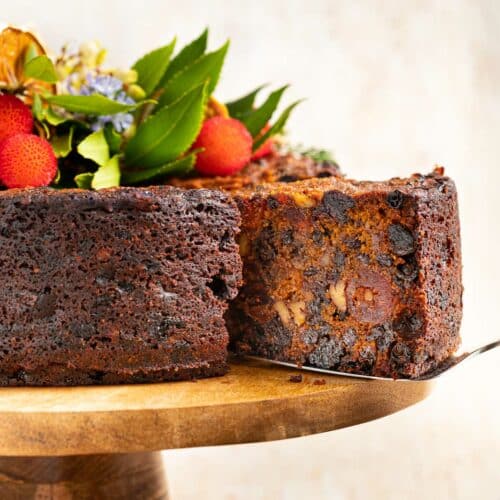
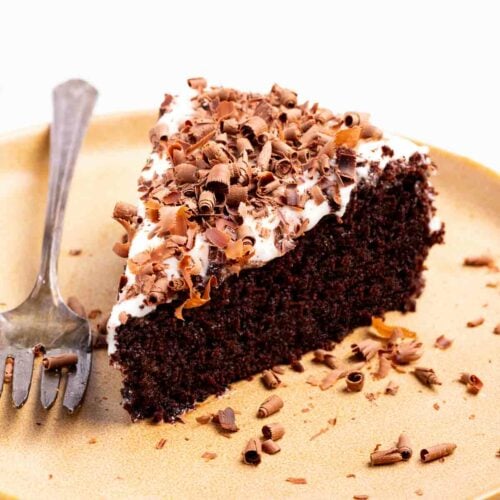
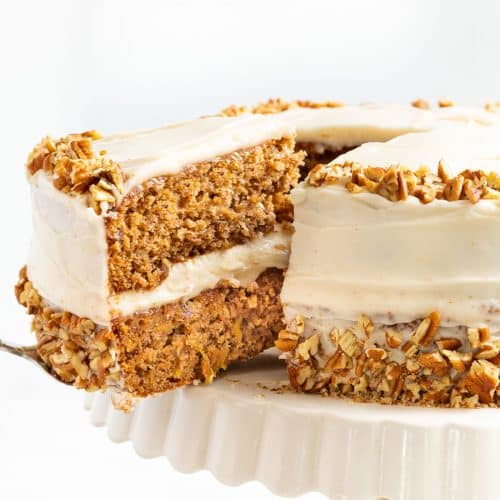
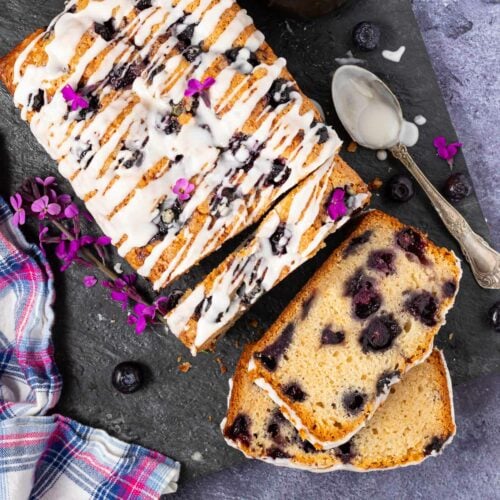
Janice says
Can this cake be made with gluten-free flour? It looks so delicious and I would love to make it!
Melanie McDonald says
I haven't tried it with this recipe, but usually a good GF baking flour with xanthan gum works well as a sub in my cake/muffin recipes.
Patricia says
This cake is in the oven and it smells amazing. I have a question regarding molasses, in the recipe it says to use dark molasses
Is dark molasses same as blackstrap molasses?
I only had fancy molasses, so my cake is looking like pumpkin cake (color wise).
Thank you for all your wonderful recipes.
Melanie McDonald says
Yes you should use dark which is the same as black strap for the full rich, dark brown colour/flavour. I believe fancy molasses is light although I’ve never seen it for sale here or used it. I’m sure your cake will still be delicious though!
Ruth says
This was one of the desserts I baked for my family's Christmas dinner meal. I followed the recipe (including measuring the flour with a scale, and using a bundt pan) and decorated it very similarly to how you decorated it. It was a show stopped in appearance - so beautiful! I loved the cake, as did three of my family members. For the rest, it was a little too strong in gingerbread/molasses flavour, and so they moved on to other desserts. I noticed that those of us who loved it all had in common that we love things like dark/strong gingerbread, dark chocolate, dark roast strong coffees, and so on. So it may not be for everyone, but it totally hit the spot for four of us - deep, dark, dense, complex in flavor, moist, and very unique. Thank you very much for the recipe - I'll be making it again next Christmas. :)
Maria says
Thank you for this wonderful recipe! I tried a few gingerbread cakes before and they never came out. But this one was just perfect, and the instructions and tips clear and helpful :)
Meredith B Domzalski says
I have a couple quick questions about the glaze. First, can I make the glaze on the side to be poured on later, or will it firm up too much to make that possible? In other words, can I have it so that people who love the glaze can pour on their own when they serve it? (I love a good orange glaze and made this recipe last year with it for a work party, and people loved it; but, alas, my family likes things a little bland, lol.)
Second, will this still store well if I don't use the glaze and make this on Christmas Eve to serve serve after Christmas dinner? I was thinking that if I don't use the glaze at all, I'd sprinkle a little powdered sugar over top of it before serving. I wasn't sure how much not having the glaze on would affect the moisture level of the cake. Thanks!
Melanie McDonald says
It will be fine. This cake keeps really well and the flavor gets better and better. Store at room temperature not in the fridge and keep it tightly covered. It stays moist for days and days.
As for the glaze, I would make that right before serving because it will firm up if left for long. Have it measured out ready to go before and then it only takes a few minutes to mix together.
Merry Christmas!
Natalia says
I made this cake today and no piece left at the end of the family and friends dinner!!! Everyone wanted to try my vegan cuisine and this cake turned out delicious. I made same frosting and decoration and it was so cute. Now I need to leave few comments. I followed the receipt and measurement strictly. And 150ml molasses/hot water left as it would be too running if I had to add all. I used same type of molasses however maybe in France it’s different from yours. I had to make additional 1/2 of receipt to fill my new baking form. After 47 min it was done! Moistured, bit sticky and nicely spicy. Everyone enjoyed it! What could help me is a video receipt as I struggled with the liquid left. But finally I was perfect!
A Virtual Vegan says
So pleased everyone enjoyed it! The amount of molasses and water is correct. All of my recipes are tested thoroughly by myself and my recipe testers. There is a lot of liquid but that's necessary for a very moist cake-like gingerbread. It's also necessary for the rich flavour and stickiness. The batter should be easily pourable but it's not really, really runny. If following my instructions you should have been alternating the wet and dry ingredients while mixing gently and ending with the dry ones, so all of the liquid would already ave been added before you added the last of the flour. I'm not sure why you ended up with some water/molasses left.
I'm pretty sure molasses is the same in France. I've bought it and cooked with it there and it seemed the same. You could also use British black treacle if you prefer. It's pretty similar.
Vardit Peer says
This cake looks fabulous, but I honestly don't know how the flavor is going to go over with my family, so I will make it in the loaf pan to reduce the recipe. Worse case scenario, I'll have to eat all myself. Not such a terrible thing.
Do you ever use spelt flour in your recipes. I prefer spelt and substitute it in most of most of the cakes and cookies that I make, but because this is such a moist cake, I wanted your thoughts on it.
Thank you for your wonderful site and Merry Christmas!
A Virtual Vegan says
I use spelt flour in a lot of my recipes. It's one of my favourite flours to use. This recipe has only been tested with white flour though, but I'm pretty sure spelt will work out just fine. Just be sure to weigh it so you get exactly the right amount. If using cups it won't be accurate because 1 cup of spelt weighs less than 1 cup of all purpose flour. Hope that helps and that you enjoy it!
Nicola says
Hi, I have just made the applesauce from two quite large apples and it has made more than two cups. The recipe calls for 1/4 cup. How much should I use. Thanks.
A Virtual Vegan says
You need to use the amount of applesauce stated in the recipe. 4 tablespoons.
Nicola says
I’ve just had a trial run on the ginger cake, sooo delicious, a definite Christmas pudding warm with custard. Thanks for the great recipes?
A Virtual Vegan says
Yay! Dessert trial runs are always a good idea. It's an excuse to eat more of them! ;O)
Wendy says
Hi Mel,
Have you ever made this cake gluten free? I’d like to make it for friends that are gluten free, but I’m always a little worried if gf flour will give the same results. Thank-you in advance.
A Virtual Vegan says
I haven't, sorry. I would think Bob's Red Mill 1 for 1 all purpose flour would be your best bet for getting a decent result though if you do want to try it. In the recipe notes I have instructions for making it in a loaf pan. It might be wise to practise with that size first just in case it doesn't go to plan.
Wendy says
Thank-you Mel!
Kelly Bayley says
This beautiful cake is baking in my oven as I write this and it smells heavenly. We will serve it on Christmas day. I just love your site and all your delicious recipes! Thank you!
A Virtual Vegan says
Thank you so much Kelly. I hope you enjoy it. Merry Christmas!
Denise says
Cake looking good baked. Decorating tomorrow. I have used 50/50 treacle and golden syrup so will let you know what everyone though about the taste after it’s eaten on Christmas Day.
Susan Maxey Townsend says
For the gingerbread cake, can I sub gf flour? Any suggestions?
A Virtual Vegan says
I haven't tested it with gluten-free flour so can't say for sure. I would imagine a good all purpose flour like Bob's Red Mill 1 to 1 baking flour would be ok. Oat Flour might be ok with some tapioca flour added too for structure. It's hard to say without having tried it.
Kathy says
This cake was amazing! I brought it to my work today and got rave reviews! I’ll be making it again for Christmas Eve.
A Virtual Vegan says
Thats awesome Kathy. I'm really pleased everyone enjoyed it!
Shari Denker says
Wonderful!!!! I was forced to take creative license but know the original is better but this is excellent. I had only 1/2 cup molasses so added 1/2 cup pure maple syrup, had to swap canned pumpkin for applesauce and opted to use dairy free egg nog in the glaze...so delicious Thank you!
A Virtual Vegan says
I'm glad you enjoyed it and were able to make it work with what you had!
Angela says
Oh Melanie this cake is sooo pretty with lots of spices too which I love. I'm sure that it tastes divine. I'll have to wait until Saturday before I can even think about putting the oven on because it's so darn hot here (Adelaide S Australia). It's still 38 degrrees C and it's past 8.00pm : ( Roll on the cool change - it can't come fast enough for me and summer has only just begun.
You were saying that it improves with keeping. Remember the English malt loaves? So sticky and gooey and nice but probably not very good for you.
Happy Christmas? Do you have snow? Probably very treacherous underfoot but so pretty to look at : )
A Virtual Vegan says
I can't even imagine baking when it's that hot so don't blame you at all for waiting.
You've evoked memories with the mention of malt loaves. Soreen! They were so good!
We don't have snow. We are in the only part of Canada where it rarely snows and rarely even goes below freezing. But if we want some snow we can drive about 2 hours up island to Mount Washington. There is lots there. It's nice to be able to experience it for fun and not have to live with it!
Merry Christmas to you too and I hope you enjoy the cake when you get to give it a try!
Alexandra says
Hi Melanie, this recipe is amazing! It is a perfect choice of vegan cake for Christmas. Can I replace molasses or a part of molasses with brown sugar? In what proportions? In my country it isn't very common to use or find molasses in stores. I understand that this change may affect the color and taste of the cake, but ... Could you explain me how to replace a part of the molasses with brown or coconut sugar? Thank you and Happy Christmas!.
A Virtual Vegan says
Thank you! I haven't tested it that way so can't guarantee results and it will need quite a bit of changing. If I were going to try omitting the molasses, I would use a total of 1 cup of dark brown sugar, not coconut sugar. Dark brown sugar is important for the molasses flavour and the texture. I think I'd increase the applesauce to 1/2 a cup / 8 tablespoons. The baking soda will no longer work as you need the acid from the molasses to react with it, so you will either need to increase the baking powder (maybe to 3 teaspoons) or add a teaspoon of apple cider vinegar and keep the baking soda. You won't need the hot water anymore, so maybe plant milk instead but a much lesser amount. Enough to make a cake batter type consistency.
If you are able to find treacle or golden syrup it would be much easier to use a combination of those in place of the molasses and keep everything else the same.
Hope that helps!
Alexandra says
Thank you for answering, for developing recipes and sharing them with us, the changes you indicate show me all your work behind each recipe you share with us and I value this effort very much!!. I'll try to use half of a type of cane molasses that I could find and the other half of blue agave. I understand that acid taste of the cake will change a lot, but I couldn't find the molasses that you use. Thanks for the recommendations and tips, I'll tell you how the cake works!.
JANE says
Wow, Melanie, so that's why you wanted to know if we all had Bundt tins?! Recipe looks totally amazing. I just want to say I really appreciate the time and effort you go to adding all the tips and tricks and explanations. The detail is amazing and very helpful. Happy xmas!
A Virtual Vegan says
Yes, that's why. I wanted to know if it was worth me buying one for this recipe. I hope you enjoy the cake if you get a chance to try it, and I'm glad you find the tips etc helpful. Thank you Jane!
Denise says
In the Uk molasses is treacle but I guess this will be good strong for this recipe. Could I substitute by using half treacle and half golden syrup instead?
A Virtual Vegan says
That's a difficult one as I can't remember what treacle in the UK tastes like. Our molasses, and the one I used in this recipe is thick, black and tastes slightly bitter, but not quite as strong and bitter as blackstrap molasses. It is nothing like golden syrup. I can remember what that was like because I used to love it!
I just checked some Delia and Nigella gingerbread recipes and they use half treacle and half golden syrup in their recipes, so I am thinking that would be the safest option. Then once you've made it once, you could maybe up the treacle percentage a little bit next time if you wanted the molasses/treacle flavour a little stronger. I hope that helps! I will add a note about this one the recipe so that other UK people know what to do.
Denise says
Thanks Mel. Uk treacle is pretty strong but I haven’t tasted blackstrap so cant compare so I will try try the 50/50 blend and let you know how it tastes.
Denise says
I made this with 50/50 treacle and golden syrup and it had just the depth of treacle I like from a ginger cake. I agree with Mel, you will have to adjust these ingredients to your taste. Don’t change anything else because this recipe produces the most moist, delicious ?